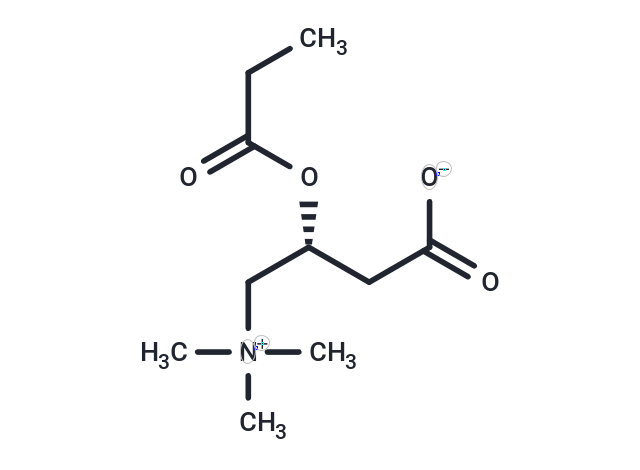Shopping Cart
- Remove All
 Your shopping cart is currently empty
Your shopping cart is currently empty

Levocarnitine propionate (L-Propionylcarnitine) is a propionyl-coenzyme A (Pro-CoA) derivative with anti-ischemic effects and high affinity for muscle L-carnitine transferase. Levocarnitine propionate enhances substrate oxidation and mitochondrial respiration in the heart of diabetic rats, reduces gastric ulcer area, induces mucosal recovery, and can be used to study acute respiratory distress syndrome and chronic gastric ulcers in Alzheimer's disease.

| Pack Size | Price | Availability | Quantity |
|---|---|---|---|
| 1 mg | $30 | In Stock | |
| 5 mg | $68 | In Stock | |
| 10 mg | $98 | In Stock | |
| 25 mg | $169 | In Stock | |
| 50 mg | $253 | In Stock | |
| 100 mg | $376 | In Stock | |
| 200 mg | $555 | In Stock |
| Description | Levocarnitine propionate (L-Propionylcarnitine) is a propionyl-coenzyme A (Pro-CoA) derivative with anti-ischemic effects and high affinity for muscle L-carnitine transferase. Levocarnitine propionate enhances substrate oxidation and mitochondrial respiration in the heart of diabetic rats, reduces gastric ulcer area, induces mucosal recovery, and can be used to study acute respiratory distress syndrome and chronic gastric ulcers in Alzheimer's disease. |
| Alias | ST-261, ST261, ST 261, Propionyl-L-carnitine, L-Propionylcarnitine |
| Molecular Weight | 217.26 |
| Formula | C10H19NO4 |
| Cas No. | 20064-19-1 |
| Smiles | [C@H](OC(CC)=O)(C[N+](C)(C)C)CC([O-])=O |
| Relative Density. | no data available |
| Storage | keep away from moisture | Powder: -20°C for 3 years | In solvent: -80°C for 1 year | Shipping with blue ice. | |||||||||||||||||||||||||||||||||||
| Solubility Information | H2O: 150 mg/mL (690.42 mM), Sonication is recommended. | |||||||||||||||||||||||||||||||||||
Solution Preparation Table | ||||||||||||||||||||||||||||||||||||
H2O
| ||||||||||||||||||||||||||||||||||||

Copyright © 2015-2025 TargetMol Chemicals Inc. All Rights Reserved.